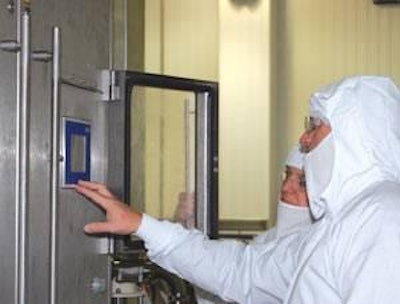
The cost of recording, storing and analyzing huge volumes of data have never been lower. Advances in communication technologies allow for data from even remote sources, like poultry houses or tractor trailers, to be collected real-time and used to better manage operations. Even with reduced hardware costs, it can take a significant capital investment to put together systems to track operations, whether on the farm, processing plant or in distribution. Implementation of these data gathering and control systems can stem from a desire to reduce costs and improve product quality through better management of the production and growing processes or from regulatory or customer requirements. Whatever the application, companies will only get a return on these investments if they succeed at putting the data to work.
In The Plant
Plant floor data collection started decades ago with weighing condemned barrels in evisceration and writing the weights down on a clipboard. Over the years, systems have evolved and improved with the advent of automated scaling systems and other innovations. The four primary drivers of plant floor data collection are enterprise resource planning (ERP) systems, plant management, customers and the government, according to Buzz Heaston, Pilgrim's Pride, Inc., who spoke at the Information Systems Seminar.
ERP systems need accurate recording of products produced, actual usage of material, and accurate inventory movements to operate effectively. Plant management needs timely feedback on everything from line downtime, product quality, actual material usage, yield reporting targets, inventory levels, truck loading schedules, and customer orders, including shortages and late deliveries to properly manage the plant. Customers need timely feedback on status of order fulfillment and deliveries; documentation of product quality and compliance with regulations and specifications. The government has regulatory requirements for HACCP, HIMP, and environmental parameters. Plant floor data collection systems can fulfill all of these needs in real-time.
Heaston said that a plant floor data collection system needs to be able to accept data collected in a number of different ways. Everything from manual recording on forms, interfaces between scale load cells and PCs, key punch into PCs, scanning bar codes or RFID readers, programmable logic control (PLC) devices, and camera view for visual inspection of product, all need to be integrated into the system.
People in a number of different jobs on the plant floor interact with a data collection system. Scale operators, stack off personnel , pallet jack drivers, warehouse personnel, quality control technicians, truck loaders, shipping and receiving clerks and supply room clerks all need to input data. The system needs to be relatively easy to use and understand so this wide variety of personnel can be trained to input data accurately.
Plant floor data collection systems are becoming more complicated and costly, and they are here to stay. Heaston said that questions remain as to how much data should be collected and how much this data is worth.
On The Road
Don Halter, Pilgrim's Pride, Inc., reported on the company's global positioning system (GPS) pilot project for its over-the-road fleet. Pilgrim's conducted the pilot project in the East Texas/Dallas area with 60 trucks. These trucks were outfitted with on board computers and GPS equipment, and the drivers were trained on procedures.
GPS data tracks where the vehicle goes and when it stops. The system also records sudden deceleration, and this aids in accident reconstruction. Data was used to coach drivers and plan trips better to conserve fuel and reduce maintenance costs. The system can also produce a Department of Transportation (DOT) log for the driver and provide records for state fuel taxes.
A GPS system could improve customer service by helping drivers hit specific delivery windows and giving real-time delivery status, according to Halter. Eventually, the data generated by the GPS system could be used by routing systems, dispatch, billing and invoicing, payroll and maintenance systems. He said that the drivers don't like the GPS, probably because of the feeling that "big brother is watching." The project was deemed to be a success, and it is being rolled out companywide to 1,800 trucks over an 18-month period.
On The Farm
The last frontier for real-time data gathering in the poultry industry is on the farm, but this frontier is about to be conquered. Mike Czarick, extension engineer, University of Georgia, envisions a day when poultry house controllers will be linked together on a farm either by wire or WiFi and the data from the entire farm will be transmitted via the Internet to a central computer at the integrators office. Several integrators are experimenting with gathering data in this manner on a few of their farms.
Dominic Hervieux, president E2E Resolution, outlined the approach that his company is taking in designing systems to integrate all of the data from poultry house controllers into a central database. Hervieux said that industrial WiFi radios can link all of the controllers on a farm to a central station. The central station would have a computer which acts as a web server and it communicates with the controllers via WiFi and with the integrator's server via the Internet. He said that it would be best if the Internet connection was high speed, but that this is not essential.
The link from the farm to the integrator's server can be a two way link, so data can be uploaded, and instructions can be downloaded. For instance, it would be possible for something like a new lighting program to be downloaded from the grow-out office to the controllers on all of the farms.
Real-Time Data
Real-time data from the houses could be used to provide alerts to the grower and to service people when things like temperature or heater run times are out of line. The system could send e-mail messages to service people which could help them plan their farm visits for the day. The data gathered over time could be analyzed to find correlations between house conditions and good or bad performance and point out areas that should be explored to help reduce operating cost or improve bird performance.
Czarick gave the example of propane usage and heater run time. "One of the best tells for energy efficiency is, did all of the heaters run for the same amount of time? If they all did, then you are relatively energy efficient. What kills you is if one heater runs 12 hours and another one runs an hour," Czarick said. "If this is happening then you have a house leakage or ventilation problem."
One stumbling block for on-farm data gathering is that controller manufacturers are not all using the same communication protocols. Czarick said that market demand for centralized data gathering systems will ultimately force controller manufacturers to use common protocols, just as equipment manufacturers have done in other industries.
Ultimately, the impetus to push integrators to implement real-time on-farm data collection may come from outside the industry. "The driving force might be something like a customer's animal welfare requirements. For instance (if on-farm ammonia sensors become practical), we might want to have a record of humidity, ammonia and temperature in your houses. You could get immediate feedback on this if the controllers are integrated into a complete system."
Data Costs
Improvements in technology have made real-time data collection a reality for the poultry industry, but all of this data collection has a cost. Organizations that are not used to managing by the numbers may struggle finding ways to put all of this data to work. There is an old axiom that, "What gets measured, gets fixed." This is true, but only if emphasis and management attention is directed at what is getting measured. Any data collection system has to be geared towards identifying and highlighting areas of opportunity and not just burying people in data.


















